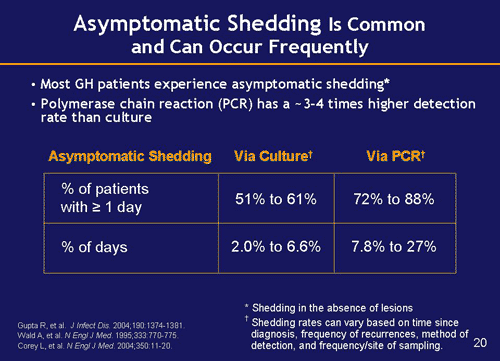Asymptomatic Shedding
What is Viral Shedding?
When the herpes virus is not active on the surface of the skin it resides in a sleeping state inside the nerve cells and other tissues. At times (which cannot always be predicted), the virus will become active and travel the nerve pathways up to the surface of the skin.
It is at these times when the virus has ‘surfaced' to the skin that viral shedding occurs. Viral shedding is when the herpes virus is active and "shedding" at the site of infection. The herpes virus is considered contagious during this "active" time and can therefore be spread through direct contact with the infected area.
It is possible for the virus to be actively shedding itself at the site of infection without showing any visible signs or symptoms. This is referred to as "Asymptomatic Viral Shedding".
Once infected with HSV1 or HSV2, a person is capable of transmitting the virus forever, even when there are no symptoms present. Transmission that occurs when there are no visible symptoms is a result of asymptomatic viral shedding.
How often shedding happens
Genital herpes infection due to HSV-2 is one of frequent viral shedding. During the first 6 months of infection, shedding can occur during 20% to 40% of days; with longer-term infection, shedding may occur during 5% to 20% of days. Here is the shedding rate after the first year by different types.
- HSV 2 genital: 15-30% of days evaluated
- HSV 1 genital: 3-5% of days evaluated
- HSV 1 oral: 25% of days evaluated
- HSV 2 oral: 1% of days evaluated

It is the shedding of virus -- and particularly asymptomatic viral shedding -- that is responsible for the transmission of genital herpes. Asymptomatic viral shedding is the presence of virus in the absence of clinical signs or symptoms.
Viral shedding means the virus is active on the skin. HSV can shed before an active outbreak (the prodromal period), during an outbreak, during the healing process following an outbreak, and also at random when there are no noticeable symptoms, and that is called asymptomatic viral shedding, or simply, asymptomatic shedding.
- In general, people with HSV1 asymptomatically shed the virus about 5% of the time.
- In the first year of infection, people with HSV2 asymptomatically shed the virus about 6-10% of the time.
Over time, though, the percentage someone sheds the virus asymptomatically is said to decrease.
Up to 70% of new infections can be attributed to asymptomatic shedding.
Asymptomatic shedding occurs in virtually all HSV-2 infected patients, and shedding rates cannot be predicted on the basis of age, sex, or reported history of outbreaks. Shedding of virus can occur from multiple genital sites, and 50% of asymptomatic shedding events occur more than 7 days before or after a clinical outbreak. And although viral shedding tends to diminish over the course of infection, the rate of decay is measured in years and the potential of transmission persists.
Where and when will Viral Shedding occur?
Due to the fact that viral shedding can occur without any signs or symptoms, it is impossible to determine exactly when viral shedding is occurring. For this reason, there will always be a small risk of transmission.
You can however determine your high risk periods and completely avoid contact with the infected area during these times. For people who experience active outbreaks, shedding is most likely to occur a few days before any symptoms show and as soon as there are any sensations warning that an outbreak is starting.
Whenever there are noticeable symptoms, and a few days after the outbreak has healed, are also high risk times for shedding. Condoms can be used in between the high risk times and medications can be taken to further reduce the risk.
How long can asymptomatic shedding last?
According the research of Dr. Phipps of the University of Washington and the Fred Hutchinson Cancer Research Center, Seattle. Herpes Viral Shedding goes beyond 10 years. Duration of any reactivation and subclinical reactivation episodes did not change over time, but the duration of clinical episodes did decrease significantly, from a median of 8.5 days within 1 year, to 5.8 days at 19 years, to 5.0 days at 10 years and beyond.
Does Valtrex reduce asymptomatic shedding?
Although the suppression of viral replication is not complete, valacyclovir and acyclovir are highly effective in suppressing the frequency and quantity of genital HSV shedding. Asymptomatic viral shedding occurred in a substantial number of HSV-2 seropositive subjects without a history of genital herpes. Valacyclovir 1 g daily significantly reduced asymptomatic shedding compared with placebo in this population.
What can I do to help reduce the risk of Asymptomatic Viral Shedding?
There are things that you can do to reduce (but not eliminate) the risk of herpes viral shedding.
- Avoid contact with the infected area a few days before, during and after any symptoms are noticed.
- Use latex condoms in between outbreaks to help protect against shedding.
- Antiviral Medications and some herbs, such as Olive Leaf, have been proven to help reduce herpes viral shedding, helping to lower (but not eliminate) the risk of transmission.
Have herpes & feel alone? Meet nearby people with herpes

PositiveSingles is one of the most popular dating websites for people suffering from herpes and other STD. It was initiated in 2001. With 1,510,800+ members you are sure to find lots of potentail people around you.
Join and meet nearby people with herpes, browse profiles and chat now!
Know more facts about herpes outbreak:
First herpes outbreak | Recurrent herpes outbreaks | Stages of a herpes outbreak | How long does a herpes outbreak last | How often do herpes outbreaks occur? | What can trigger herpes outbreaks? | How to recognize a herpes outbreak? | How to prevent herpes outbreaks | Viral shedding | Herpes treatment | How to strengthen your immune system
